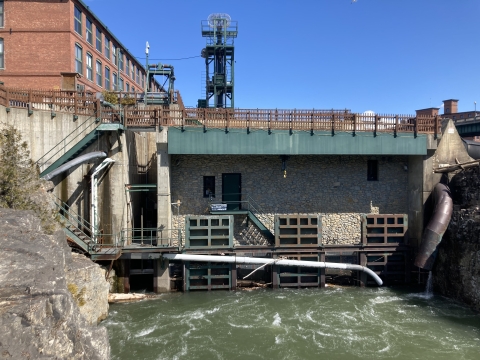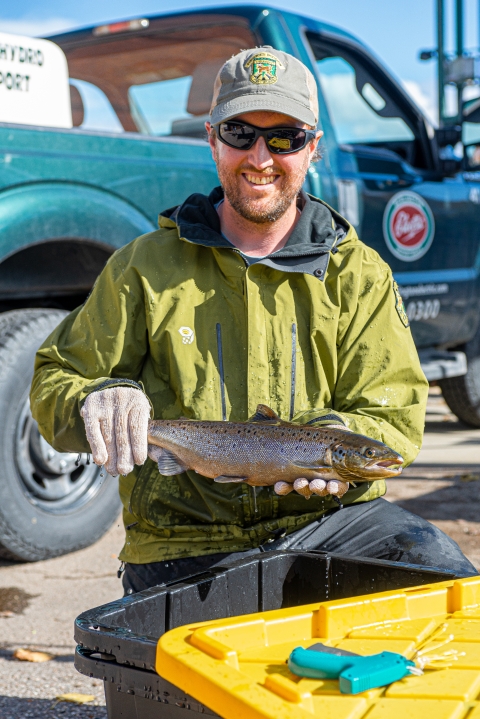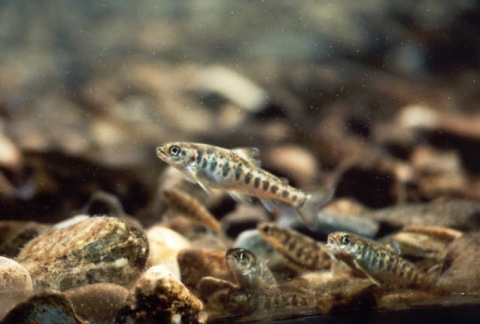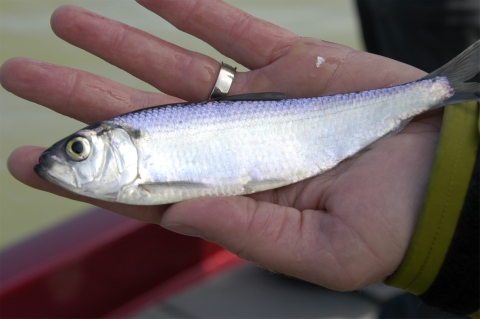Lee Simard knew October 23 was going to be the big day.
Since September, he had been making frequent trips to the Winooski One Dam, also known as Chace Mill, to assess and count migrating landlocked Atlantic salmon taking the fish elevator — a metal hopper full of water — to the top of the hydroelectric station on Vermont’s Winooski River.
Staff from Burlington Electric, operator of the dam, run the elevator each day and place the fish they collect in a holding tank of river water to await an evaluation by Simard, who is a district fisheries biologist with the Vermont Fish and Wildlife Department.
“We collect data on length, weight, sex, and genetics,” Simard said. “Then we put them in a tank in the back of a pickup truck to be driven upstream past two other dams.”
Since 1993, the “Trap and Truck” fish-passage program has made it possible for salmon migrating up the Winooski from Lake Champlain to access more than 20 miles of spawning habitat beyond these barriers.
This year, along with its 30th anniversary, the trap-and-truck program celebrated a new milestone.
By mid-October, the salmon tally at the dam was nearing 189 — the previous record for a season. On October 23, Simard counted fish number 190. “It was exciting,” he said.
It wasn't over yet. By the time the season ended in late November, the total had reached 212 — an 12% increase from the previous high.
“It's the highest number we’ve recorded in 30 years of monitoring,” said Laurie Earley, supervisory fish biologist at the U.S. Fish and Wildlife Service’s Lake Champlain Fish and Wildlife Conservation Office.
That number is an indicator of the success of a multi-decade, multi-partner effort to restore salmon to the Lake Champlain basin, led by the Lake Champlain Fish and Wildlife Management Cooperative — a partnership between the Service, Vermont Fish and Wildlife Department, and New York Department of Environmental Conservation, along with many advisors like the University of Vermont and the Lake Champlain Basin Program.
It’s also the sum of many parts. “There are many factors that account for the increase,” Earley said. “The story about salmon restoration here is about more than the Winooski River.”
Comeback
In the late 1800s, salmon in the Lake Champlain basin started to swim up against numerous challenges: overfishing, agricultural runoff, development, and — the deal-breaker for a migratory fish species — dams built across rivers. If salmon can’t reach the cool, shallow, gravel stream beds they need to spawn, they simply won’t reproduce. End of story.
For the last 30 years, the trap-and-truck program has turned what had long been a dead end — the first dam on the Winooski River — into a short-cut to their destination.
The excitement around the record-breaking count this year isn’t just about more salmon showing up; it’s about more salmon coming back.
A lot of those 212 salmon were born in either a state or federal fish hatchery. The Dwight D. Eisenhower and White River national fish hatcheries, Vermont-run Ed Weed Fish Culture Station, and New York State-run Adirondack Fish Hatchery all work together on fish production and assessment across the Lake Champlain basin.
Hatchery-reared salmon are released directly into the Winooski as smolts — the life stage when they naturally want to head downstream to feed and grow large in the lake. Releasing these smolts in the river is also a way to increase imprinting on the Winooski River and get fish to return. Bacteria in the water and biofilms on the rocks give off chemical cues that a juvenile salmon can key into, leaving an olfactory trail of breadcrumbs they can follow back years later when it’s time to spawn.
But for a long time, most salmon weren’t surviving long enough to make this return trip in the fall.
Setback
In the 1970s, the Cooperative began raising salmon from a strain originating in Sebago Lake, Maine — home of one of the last remaining native populations of landlocked Atlantic salmon in the U.S.
But shortly after partners started stocking hatchery-raised Atlantic salmon — as well as lake trout —into the lake and its tributaries in large numbers, sea lamprey numbers started to increase as well. The population of this invasive, parasitic fish had remained small since their presumed appearance in the basin in the early 20th century, but once presented with a food source that had been absent at the time of their arrival, sea lamprey boomed.
A sea lamprey doesn’t exactly eat a salmon; it scrapes a hole through the salmon’s side with its razor-like tongue — reminiscent of a cheese grater — and sucks out the bodily fluids. Important stuff like blood, bile, and serum.
At the height of the sea-lamprey explosion, biologists were documenting flesh wounds on 79 out of every 100 Atlantic salmon in Lake Champlain. Many wounded fish were dying directly as a result of parasitism or indirectly from infections borne of the gaping, exposed wounds.
In 1990, the Service and the states launched a pilot program to experiment with methods developed in the Great Lakes for suppressing sea lamprey.
What started as a pilot has evolved into a cornerstone of the salmon and lake trout restoration program: a strategic, long-term, lamprey-control program that involves tactical application of lampricide to kill larvae and temporary barriers to trap adults during seasonal migrations, all guided by comprehensive assessments of sea lamprey throughout their lifecycle.
Which brings us to another important indicator — and another record broken. In 2022, sea lamprey wounding rates for salmon dropped to about six per 100 salmon, and management targets were met for both salmon and lake trout for the first time since control program began.
New hope
The drop in sea lamprey wounding rates is just one contributor to the rise in fish-elevator ridership at Winooski One.
Partners have been working to piece together the complex salmon restoration puzzle on multiple fronts: restoring instream habitat and stabilizing riverbanks, improving downstream passage at dams so fish can get back out to the lake in the spring, removing upstream passage barriers, evaluating different fish stocking strategies, and experimenting with propagation techniques to increase salmon fitness in the face of unexpected challenges. Like alewife.
A type of river herring not native to the lake, alewife appeared in 2003 and soon crowded out rainbow smelt, the primary food source for salmon. Salmon began eating alewife instead — which turned out to be a poor substitute. Alewife carry an enzyme called thiaminase that breaks down the essential vitamin B1 in fish that ingest them, causing neurological dysfunction and decreased survival in adults and low reproductive success.
While it would be virtually impossible to rid the lake of alewife, partners still have reason to hope for the long-term success of salmon in the basin. In 2017, scientists found a natural-born salmon fry in the Winooski River for the first time in 150 years, suggesting there were female salmon out there with enough vitamin B1 to pass on to their offspring for the young to survive an alewife-rich diet.
Family matters
Following this hunch, biologists conducted a study tracking the offspring of adult fish that had been foraging on alewives to see which ones survived. “Most families had almost complete mortality from vitamin B deficiency — but a few families had a lot of survivors,” said Kurt Heim, a fish biologist at the Lake Champlain Fish and Wildlife Conservation Office.
A closer look at the results provided strong evidence for a genetic basis for the difference in survival. Based on that information, biologists used the survivors to propagate a new line of fish for breeding — called a broodstock broodstock
The reproductively mature adults in a population that breed (or spawn) and produce more individuals (offspring or progeny).
Learn more about broodstock — at the White River National Fish Hatchery.
“In a way we’re helping to facilitate an evolutionary response to a major hurdle to salmon restoration,” Heim said. “This is an innovative approach to salmon restoration made possible by great partnerships with the states and our federal hatcheries. I am really excited to see how these fish do out in the wild.”
He’ll soon find out.
The next chapter
Evaluations are now underway using a new technique called parentage-based tagging, in which genetic samples are collected from adult fish in the hatchery — usually a small clip from a fin — so offspring that are sampled in the future can be linked back to their parents through DNA. This approach gives scientists a way to compare survival and reproductive success of the low-thiamine tolerant broodstock to other broodstock sources.
“Because of the trap-and-truck program, the Winooski One Dam is the best location to monitor whether salmon from that experimental broodstock are surviving,” Earley explained. “Being able to get our hands on fish, allows us to get a tissue sample from the fish’s fin, which we can analyze to determine who the fish's parents are and which broodstock it’s from.”
It will take another couple of months to analyze the genetic data from this year’s cohort of trapped-and-trucked salmon to determine who their parents are. But it’s clear where this story is going.
“We are at a point in time where all our investments — in habitat, aquatic connectivity, stocking, and invasive-species management — are starting to pay off,” Earley said.









